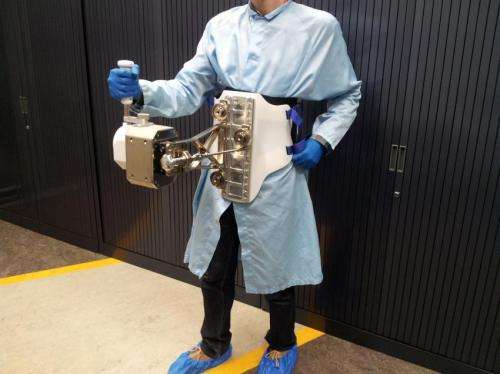Final flight of European space vehicle to Space Station goes out with a 'Big Bang'

The fifth and final mission of the European Space Agency (ESA) Automated Transfer Vehicle (ATV), scheduled for launch on July 29, will deliver new research investigations to the International Space Station. The ATV-5 spacecraft bears the name of Belgian physicist Georges Lemaître, who is considered to be the father of the big-bang theory. This final flight of the ATV program will deliver joysticks for robotic video games, new clothing, a new laser imaging system for spacecraft rendezvous and aquarium fish.
Several of these items are for use in ESA research and are featured studies as part of German astronaut Alexander Gerst's Blue Dot mission. The ESA-Haptics-1 study involves installation of a highly advanced joystick on the space station, designed for the study of remote control of robots on Earth by astronauts in space. The joystick can be manipulated freely by an astronaut, much like a standard video gaming joystick, while the joystick generates return forces that the astronaut will feel. The joystick is mounted to the body via harness and can be fixed to stable equipment on the space station to prevent the joystick's force feedback from pushing the astronaut.
The astronaut will use the joystick to play simple Pong-style computer games. Pong is a simulated table tennis video game. Readings from these space games and follow-up questionnaires will provide a better understanding of human motor control when exposed to weightlessness and how feedback feels during a long-duration spaceflight.
The ESA-Haptics-1 experiment is part of ESA's Multipurpose End-To-End Robotic Operations Network (METERON) investigation. The study's goal is to validate technology for future human exploration missions during which an astronaut in orbit would control a robot as it explores its target, such as an asteroid or Mars. The remote operation techniques developed for METERON may lead to uses on Earth in telemedicine and for operating robots in hazardous environments, such as in handling radioactive material or working in a nuclear power plant after a leak.

Future space fashion designers may take note of ESA's Spacetex investigation, which seeks to analyze the interaction between the body, clothing and climate in space. In microgravity, sweat tends to stay where it forms on the body due to surface tension trapping the moisture. This prevents evaporation of the moisture, which is what helps cool the skin on Earth. This may create a physiological strain on the body. To counteract this loss of the body's cooling mechanism, researchers study unique textiles and adapt them for use in space.
Specifically, scientists will test textiles made by Schoeller Textil AG in orbit to see how the clothing wicks body heat and sweat away from the body. The textiles are single- or multi-layer knitted products which use both spun and textured yarns. This mixture of yarns allows moisture to move from the first layer to the outer layer, where it can evaporate. This testing will provide information for developing new textiles for use in areas on Earth subject to extreme climate or physiological conditions. The innovative textiles could include antimicrobial materials that minimize odor as bacteria breaks down body sweat. Data from the study also may help to optimize astronauts' clothing for future long-duration missions.
New Laser InfraRed Imaging Sensors, or LIRIS, aboard ATV-5 will allow researchers to test new rendezvous and docking sensors as the spacecraft approaches the space station. ATV-5 is scheduled to perform a station fly-under maneuver a few days before docking to demonstrate an infrared camera system which scans the station. Then, lidar sensors, which are the light equivalent of radar, will be tested during final approach to the station.
Previously, the ATV optical guidance system used satellite navigation at long range and optical sensors on final approach to the space station. This system bounced light off strategically placed reflectors mounted on the aft end of the station's Zvezda Service Module. The LIRIS system does not require the reflectors, permitting future missions to rendezvous with almost any object in orbit. ESA hopes this LIRIS test will enable future spacecraft to rendezvous and dock with uncooperative targets in orbit, such as nonfunctional satellites and space debris.
Discover the latest in science, tech, and space with over 100,000 subscribers who rely on Phys.org for daily insights. Sign up for our free newsletter and get updates on breakthroughs, innovations, and research that matter—daily or weekly.
The Japanese Aerospace Exploration Agency's (JAXA) Effects of Gravity on Maintenance of Muscle Mass in Zebrafish (Zebrafish Muscle) investigation will observe the effects of microgravity on the zebrafish, Danio rerio, a tropical freshwater fish belonging to the minnow family. This investigation employs the station's Aquatic Habitat, an aquarium in microgravity. The goal of the study is to determine whether zebrafish muscles weaken in microgravity similarly to human muscles, and if so, isolate the cause.

The zebrafish is an important model organism used for scientific research and is notable for its regenerative capabilities. Model organisms such as plants, animals or microbes like yeast, are used to study the influence of microgravity on cells. Taking these organisms to space allows for examination of growth and development and physiological, psychological and aging processes without the impact of gravity.
Results from the Zebrafish Muscle investigation may help identify molecular changes involved in the deterioration of muscles exposed to microgravity. This data can help scientists develop new treatments for weakened muscles. The findings could potentially benefit patients on extended bed rest or with limited mobility, for instance. In addition, this information would aid researchers in developing countermeasures for muscle weakness in astronauts living in microgravity during extended missions.
As with most cargo resupply spacecraft, with the exception of SpaceX's Dragon, the ATV-5 will burn up upon re-entry to Earth's atmosphere after its departure from the space station. However, this time the fiery return will be recorded from the inside of spacecraft by an infrared camera, and the imagery will be transmitted to a satellite. Engineers will collect this data to test future computer models that will perform the final re-entry of the space station once it is decommissioned from orbit. From the big-bang theory to its big science bang in microgravity, ATV-5 will truly light up the sky on its space station mission.
Provided by NASA




















